A Literature Review on Student Misbehavior & Data Collection Protocol
VerifiedAdded on 2023/06/13
|12
|3457
|375
Literature Review
AI Summary
This assignment presents a literature review investigating the causes of student misbehavior and the strategies teachers employ to address it. It examines factors such as family background, teacher behavior, and classroom environment, drawing upon various research studies to highlight key themes. The review synthesizes findings on the impact of socioeconomic status, parenting styles, and teacher-student interactions on student conduct. Furthermore, it outlines a data collection protocol, including survey questions, designed to gather insights into students' perceptions of these issues, aiming to understand the effectiveness of teacher strategies in mitigating misbehavior. The research utilizes a qualitative approach to delve into the thoughts and perceptions of students, providing a comprehensive overview of the factors influencing student behavior in the classroom. The study seeks to identify actionable strategies for improving classroom management and fostering a more positive learning environment.
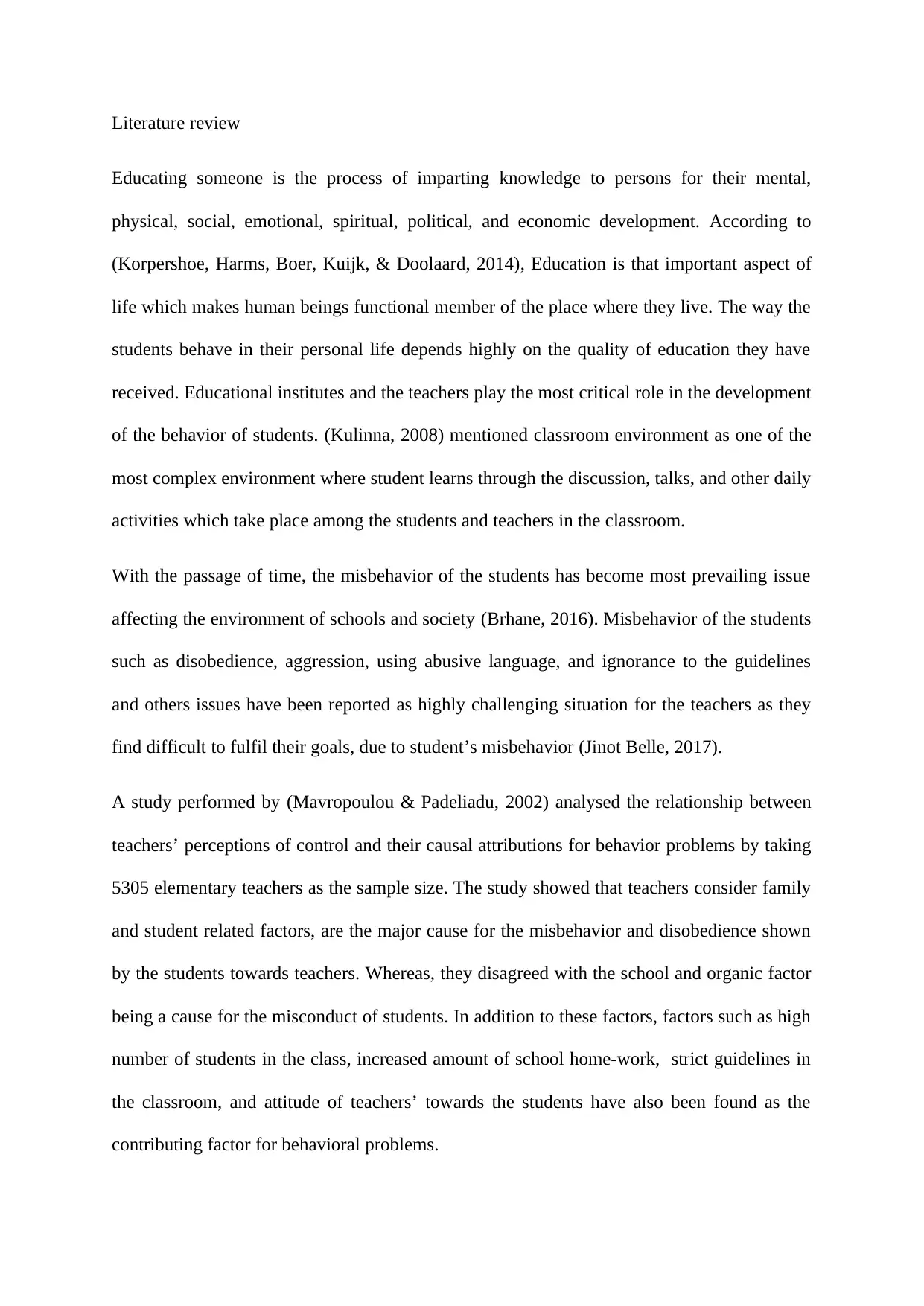
Literature review
Educating someone is the process of imparting knowledge to persons for their mental,
physical, social, emotional, spiritual, political, and economic development. According to
(Korpershoe, Harms, Boer, Kuijk, & Doolaard, 2014), Education is that important aspect of
life which makes human beings functional member of the place where they live. The way the
students behave in their personal life depends highly on the quality of education they have
received. Educational institutes and the teachers play the most critical role in the development
of the behavior of students. (Kulinna, 2008) mentioned classroom environment as one of the
most complex environment where student learns through the discussion, talks, and other daily
activities which take place among the students and teachers in the classroom.
With the passage of time, the misbehavior of the students has become most prevailing issue
affecting the environment of schools and society (Brhane, 2016). Misbehavior of the students
such as disobedience, aggression, using abusive language, and ignorance to the guidelines
and others issues have been reported as highly challenging situation for the teachers as they
find difficult to fulfil their goals, due to student’s misbehavior (Jinot Belle, 2017).
A study performed by (Mavropoulou & Padeliadu, 2002) analysed the relationship between
teachers’ perceptions of control and their causal attributions for behavior problems by taking
5305 elementary teachers as the sample size. The study showed that teachers consider family
and student related factors, are the major cause for the misbehavior and disobedience shown
by the students towards teachers. Whereas, they disagreed with the school and organic factor
being a cause for the misconduct of students. In addition to these factors, factors such as high
number of students in the class, increased amount of school home-work, strict guidelines in
the classroom, and attitude of teachers’ towards the students have also been found as the
contributing factor for behavioral problems.
Educating someone is the process of imparting knowledge to persons for their mental,
physical, social, emotional, spiritual, political, and economic development. According to
(Korpershoe, Harms, Boer, Kuijk, & Doolaard, 2014), Education is that important aspect of
life which makes human beings functional member of the place where they live. The way the
students behave in their personal life depends highly on the quality of education they have
received. Educational institutes and the teachers play the most critical role in the development
of the behavior of students. (Kulinna, 2008) mentioned classroom environment as one of the
most complex environment where student learns through the discussion, talks, and other daily
activities which take place among the students and teachers in the classroom.
With the passage of time, the misbehavior of the students has become most prevailing issue
affecting the environment of schools and society (Brhane, 2016). Misbehavior of the students
such as disobedience, aggression, using abusive language, and ignorance to the guidelines
and others issues have been reported as highly challenging situation for the teachers as they
find difficult to fulfil their goals, due to student’s misbehavior (Jinot Belle, 2017).
A study performed by (Mavropoulou & Padeliadu, 2002) analysed the relationship between
teachers’ perceptions of control and their causal attributions for behavior problems by taking
5305 elementary teachers as the sample size. The study showed that teachers consider family
and student related factors, are the major cause for the misbehavior and disobedience shown
by the students towards teachers. Whereas, they disagreed with the school and organic factor
being a cause for the misconduct of students. In addition to these factors, factors such as high
number of students in the class, increased amount of school home-work, strict guidelines in
the classroom, and attitude of teachers’ towards the students have also been found as the
contributing factor for behavioral problems.
Paraphrase This Document
Need a fresh take? Get an instant paraphrase of this document with our AI Paraphraser
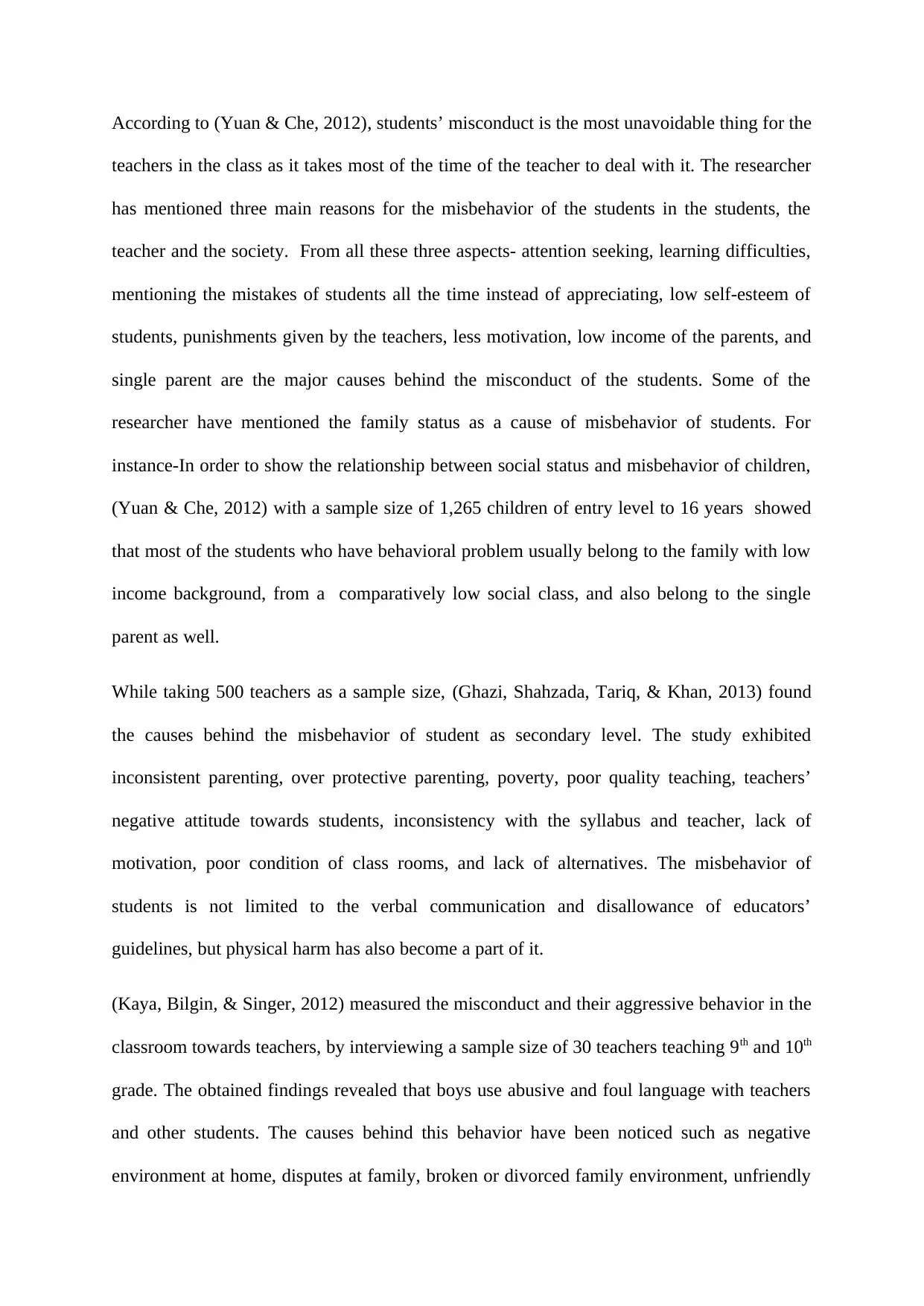
According to (Yuan & Che, 2012), students’ misconduct is the most unavoidable thing for the
teachers in the class as it takes most of the time of the teacher to deal with it. The researcher
has mentioned three main reasons for the misbehavior of the students in the students, the
teacher and the society. From all these three aspects- attention seeking, learning difficulties,
mentioning the mistakes of students all the time instead of appreciating, low self-esteem of
students, punishments given by the teachers, less motivation, low income of the parents, and
single parent are the major causes behind the misconduct of the students. Some of the
researcher have mentioned the family status as a cause of misbehavior of students. For
instance-In order to show the relationship between social status and misbehavior of children,
(Yuan & Che, 2012) with a sample size of 1,265 children of entry level to 16 years showed
that most of the students who have behavioral problem usually belong to the family with low
income background, from a comparatively low social class, and also belong to the single
parent as well.
While taking 500 teachers as a sample size, (Ghazi, Shahzada, Tariq, & Khan, 2013) found
the causes behind the misbehavior of student as secondary level. The study exhibited
inconsistent parenting, over protective parenting, poverty, poor quality teaching, teachers’
negative attitude towards students, inconsistency with the syllabus and teacher, lack of
motivation, poor condition of class rooms, and lack of alternatives. The misbehavior of
students is not limited to the verbal communication and disallowance of educators’
guidelines, but physical harm has also become a part of it.
(Kaya, Bilgin, & Singer, 2012) measured the misconduct and their aggressive behavior in the
classroom towards teachers, by interviewing a sample size of 30 teachers teaching 9th and 10th
grade. The obtained findings revealed that boys use abusive and foul language with teachers
and other students. The causes behind this behavior have been noticed such as negative
environment at home, disputes at family, broken or divorced family environment, unfriendly
teachers in the class as it takes most of the time of the teacher to deal with it. The researcher
has mentioned three main reasons for the misbehavior of the students in the students, the
teacher and the society. From all these three aspects- attention seeking, learning difficulties,
mentioning the mistakes of students all the time instead of appreciating, low self-esteem of
students, punishments given by the teachers, less motivation, low income of the parents, and
single parent are the major causes behind the misconduct of the students. Some of the
researcher have mentioned the family status as a cause of misbehavior of students. For
instance-In order to show the relationship between social status and misbehavior of children,
(Yuan & Che, 2012) with a sample size of 1,265 children of entry level to 16 years showed
that most of the students who have behavioral problem usually belong to the family with low
income background, from a comparatively low social class, and also belong to the single
parent as well.
While taking 500 teachers as a sample size, (Ghazi, Shahzada, Tariq, & Khan, 2013) found
the causes behind the misbehavior of student as secondary level. The study exhibited
inconsistent parenting, over protective parenting, poverty, poor quality teaching, teachers’
negative attitude towards students, inconsistency with the syllabus and teacher, lack of
motivation, poor condition of class rooms, and lack of alternatives. The misbehavior of
students is not limited to the verbal communication and disallowance of educators’
guidelines, but physical harm has also become a part of it.
(Kaya, Bilgin, & Singer, 2012) measured the misconduct and their aggressive behavior in the
classroom towards teachers, by interviewing a sample size of 30 teachers teaching 9th and 10th
grade. The obtained findings revealed that boys use abusive and foul language with teachers
and other students. The causes behind this behavior have been noticed such as negative
environment at home, disputes at family, broken or divorced family environment, unfriendly
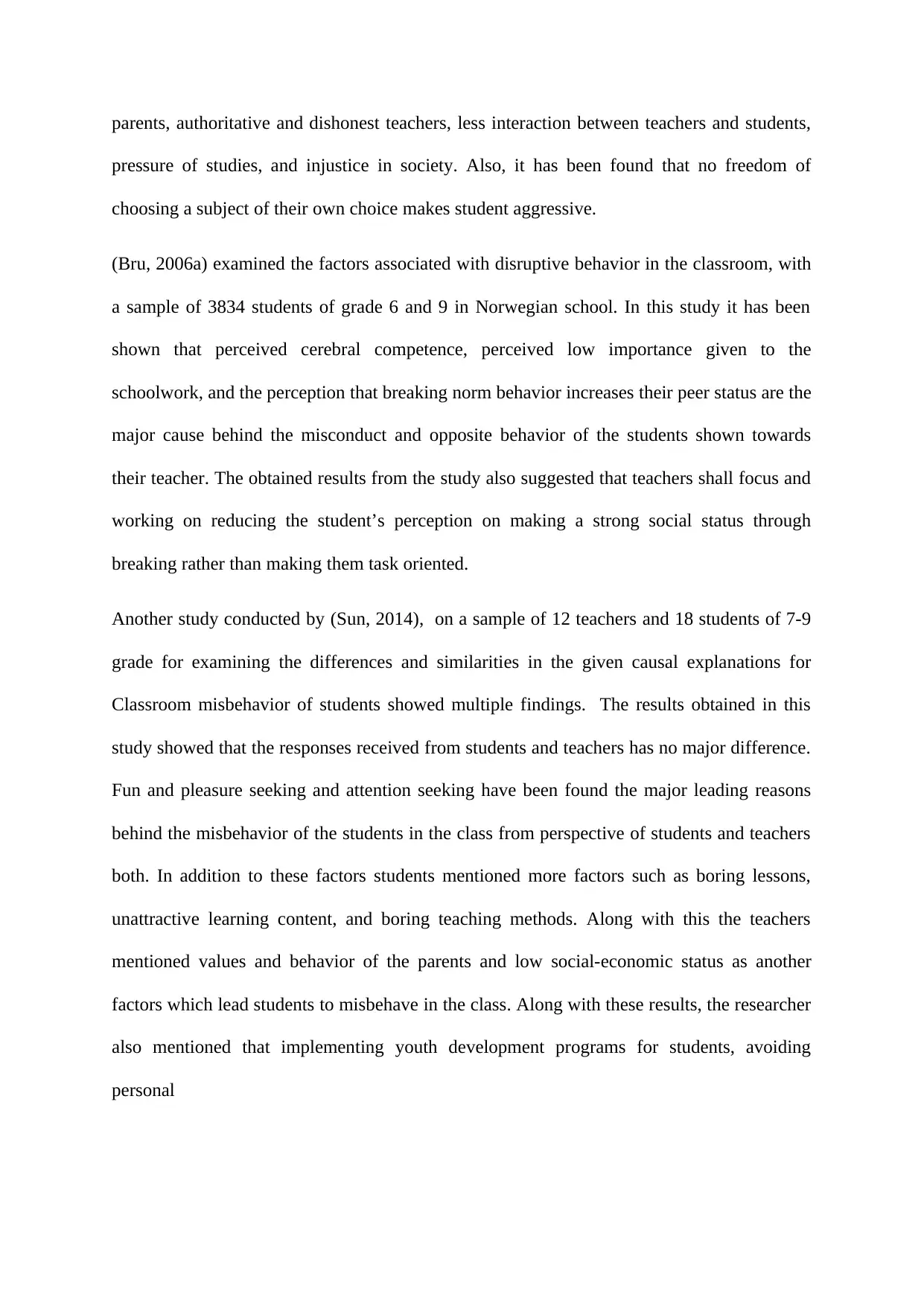
parents, authoritative and dishonest teachers, less interaction between teachers and students,
pressure of studies, and injustice in society. Also, it has been found that no freedom of
choosing a subject of their own choice makes student aggressive.
(Bru, 2006a) examined the factors associated with disruptive behavior in the classroom, with
a sample of 3834 students of grade 6 and 9 in Norwegian school. In this study it has been
shown that perceived cerebral competence, perceived low importance given to the
schoolwork, and the perception that breaking norm behavior increases their peer status are the
major cause behind the misconduct and opposite behavior of the students shown towards
their teacher. The obtained results from the study also suggested that teachers shall focus and
working on reducing the student’s perception on making a strong social status through
breaking rather than making them task oriented.
Another study conducted by (Sun, 2014), on a sample of 12 teachers and 18 students of 7-9
grade for examining the differences and similarities in the given causal explanations for
Classroom misbehavior of students showed multiple findings. The results obtained in this
study showed that the responses received from students and teachers has no major difference.
Fun and pleasure seeking and attention seeking have been found the major leading reasons
behind the misbehavior of the students in the class from perspective of students and teachers
both. In addition to these factors students mentioned more factors such as boring lessons,
unattractive learning content, and boring teaching methods. Along with this the teachers
mentioned values and behavior of the parents and low social-economic status as another
factors which lead students to misbehave in the class. Along with these results, the researcher
also mentioned that implementing youth development programs for students, avoiding
personal
pressure of studies, and injustice in society. Also, it has been found that no freedom of
choosing a subject of their own choice makes student aggressive.
(Bru, 2006a) examined the factors associated with disruptive behavior in the classroom, with
a sample of 3834 students of grade 6 and 9 in Norwegian school. In this study it has been
shown that perceived cerebral competence, perceived low importance given to the
schoolwork, and the perception that breaking norm behavior increases their peer status are the
major cause behind the misconduct and opposite behavior of the students shown towards
their teacher. The obtained results from the study also suggested that teachers shall focus and
working on reducing the student’s perception on making a strong social status through
breaking rather than making them task oriented.
Another study conducted by (Sun, 2014), on a sample of 12 teachers and 18 students of 7-9
grade for examining the differences and similarities in the given causal explanations for
Classroom misbehavior of students showed multiple findings. The results obtained in this
study showed that the responses received from students and teachers has no major difference.
Fun and pleasure seeking and attention seeking have been found the major leading reasons
behind the misbehavior of the students in the class from perspective of students and teachers
both. In addition to these factors students mentioned more factors such as boring lessons,
unattractive learning content, and boring teaching methods. Along with this the teachers
mentioned values and behavior of the parents and low social-economic status as another
factors which lead students to misbehave in the class. Along with these results, the researcher
also mentioned that implementing youth development programs for students, avoiding
personal
You're viewing a preview
Unlock full access by subscribing today!
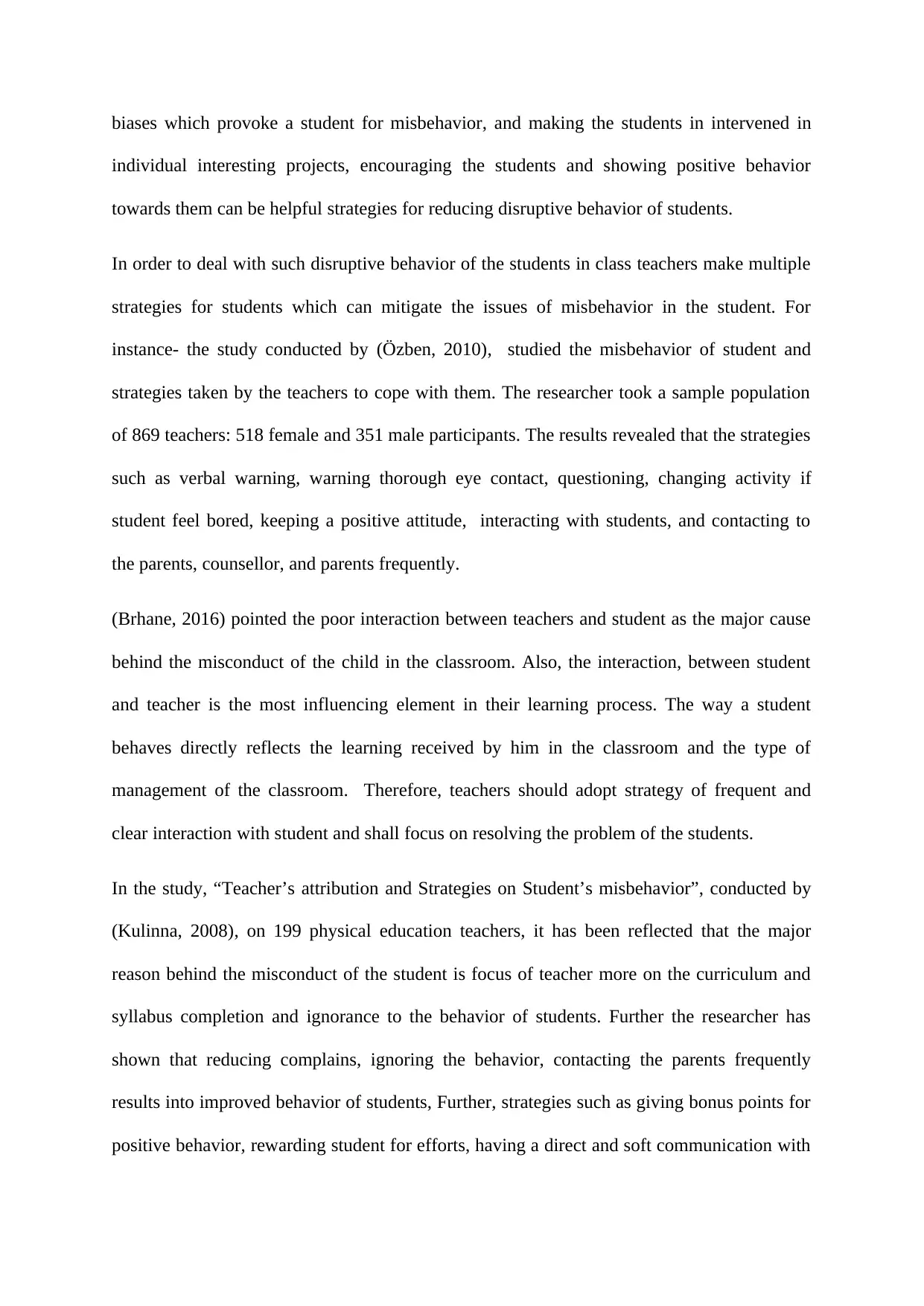
biases which provoke a student for misbehavior, and making the students in intervened in
individual interesting projects, encouraging the students and showing positive behavior
towards them can be helpful strategies for reducing disruptive behavior of students.
In order to deal with such disruptive behavior of the students in class teachers make multiple
strategies for students which can mitigate the issues of misbehavior in the student. For
instance- the study conducted by (Özben, 2010), studied the misbehavior of student and
strategies taken by the teachers to cope with them. The researcher took a sample population
of 869 teachers: 518 female and 351 male participants. The results revealed that the strategies
such as verbal warning, warning thorough eye contact, questioning, changing activity if
student feel bored, keeping a positive attitude, interacting with students, and contacting to
the parents, counsellor, and parents frequently.
(Brhane, 2016) pointed the poor interaction between teachers and student as the major cause
behind the misconduct of the child in the classroom. Also, the interaction, between student
and teacher is the most influencing element in their learning process. The way a student
behaves directly reflects the learning received by him in the classroom and the type of
management of the classroom. Therefore, teachers should adopt strategy of frequent and
clear interaction with student and shall focus on resolving the problem of the students.
In the study, “Teacher’s attribution and Strategies on Student’s misbehavior”, conducted by
(Kulinna, 2008), on 199 physical education teachers, it has been reflected that the major
reason behind the misconduct of the student is focus of teacher more on the curriculum and
syllabus completion and ignorance to the behavior of students. Further the researcher has
shown that reducing complains, ignoring the behavior, contacting the parents frequently
results into improved behavior of students, Further, strategies such as giving bonus points for
positive behavior, rewarding student for efforts, having a direct and soft communication with
individual interesting projects, encouraging the students and showing positive behavior
towards them can be helpful strategies for reducing disruptive behavior of students.
In order to deal with such disruptive behavior of the students in class teachers make multiple
strategies for students which can mitigate the issues of misbehavior in the student. For
instance- the study conducted by (Özben, 2010), studied the misbehavior of student and
strategies taken by the teachers to cope with them. The researcher took a sample population
of 869 teachers: 518 female and 351 male participants. The results revealed that the strategies
such as verbal warning, warning thorough eye contact, questioning, changing activity if
student feel bored, keeping a positive attitude, interacting with students, and contacting to
the parents, counsellor, and parents frequently.
(Brhane, 2016) pointed the poor interaction between teachers and student as the major cause
behind the misconduct of the child in the classroom. Also, the interaction, between student
and teacher is the most influencing element in their learning process. The way a student
behaves directly reflects the learning received by him in the classroom and the type of
management of the classroom. Therefore, teachers should adopt strategy of frequent and
clear interaction with student and shall focus on resolving the problem of the students.
In the study, “Teacher’s attribution and Strategies on Student’s misbehavior”, conducted by
(Kulinna, 2008), on 199 physical education teachers, it has been reflected that the major
reason behind the misconduct of the student is focus of teacher more on the curriculum and
syllabus completion and ignorance to the behavior of students. Further the researcher has
shown that reducing complains, ignoring the behavior, contacting the parents frequently
results into improved behavior of students, Further, strategies such as giving bonus points for
positive behavior, rewarding student for efforts, having a direct and soft communication with
Paraphrase This Document
Need a fresh take? Get an instant paraphrase of this document with our AI Paraphraser
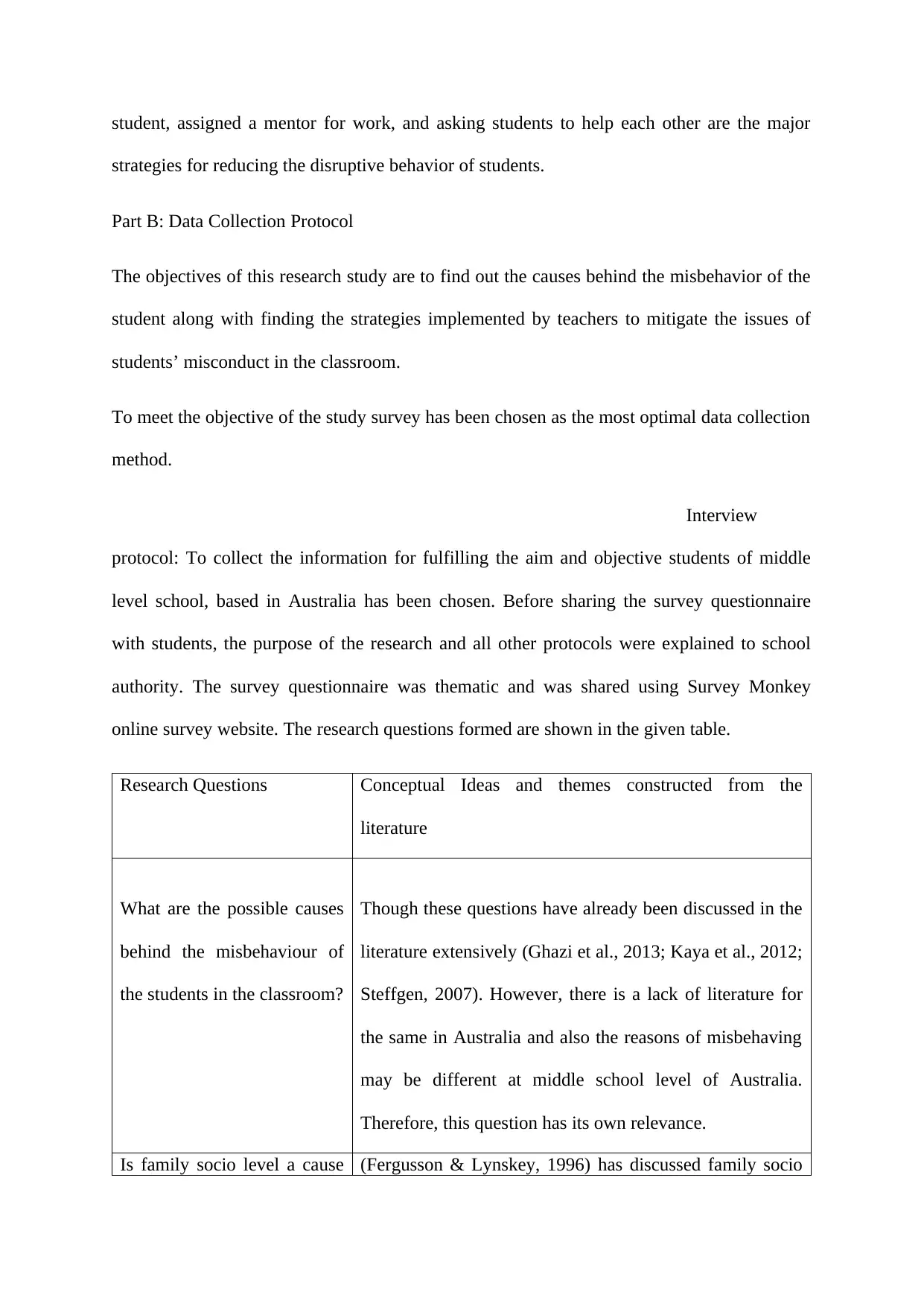
student, assigned a mentor for work, and asking students to help each other are the major
strategies for reducing the disruptive behavior of students.
Part B: Data Collection Protocol
The objectives of this research study are to find out the causes behind the misbehavior of the
student along with finding the strategies implemented by teachers to mitigate the issues of
students’ misconduct in the classroom.
To meet the objective of the study survey has been chosen as the most optimal data collection
method.
Interview
protocol: To collect the information for fulfilling the aim and objective students of middle
level school, based in Australia has been chosen. Before sharing the survey questionnaire
with students, the purpose of the research and all other protocols were explained to school
authority. The survey questionnaire was thematic and was shared using Survey Monkey
online survey website. The research questions formed are shown in the given table.
Research Questions Conceptual Ideas and themes constructed from the
literature
What are the possible causes
behind the misbehaviour of
the students in the classroom?
Though these questions have already been discussed in the
literature extensively (Ghazi et al., 2013; Kaya et al., 2012;
Steffgen, 2007). However, there is a lack of literature for
the same in Australia and also the reasons of misbehaving
may be different at middle school level of Australia.
Therefore, this question has its own relevance.
Is family socio level a cause (Fergusson & Lynskey, 1996) has discussed family socio
strategies for reducing the disruptive behavior of students.
Part B: Data Collection Protocol
The objectives of this research study are to find out the causes behind the misbehavior of the
student along with finding the strategies implemented by teachers to mitigate the issues of
students’ misconduct in the classroom.
To meet the objective of the study survey has been chosen as the most optimal data collection
method.
Interview
protocol: To collect the information for fulfilling the aim and objective students of middle
level school, based in Australia has been chosen. Before sharing the survey questionnaire
with students, the purpose of the research and all other protocols were explained to school
authority. The survey questionnaire was thematic and was shared using Survey Monkey
online survey website. The research questions formed are shown in the given table.
Research Questions Conceptual Ideas and themes constructed from the
literature
What are the possible causes
behind the misbehaviour of
the students in the classroom?
Though these questions have already been discussed in the
literature extensively (Ghazi et al., 2013; Kaya et al., 2012;
Steffgen, 2007). However, there is a lack of literature for
the same in Australia and also the reasons of misbehaving
may be different at middle school level of Australia.
Therefore, this question has its own relevance.
Is family socio level a cause (Fergusson & Lynskey, 1996) has discussed family socio
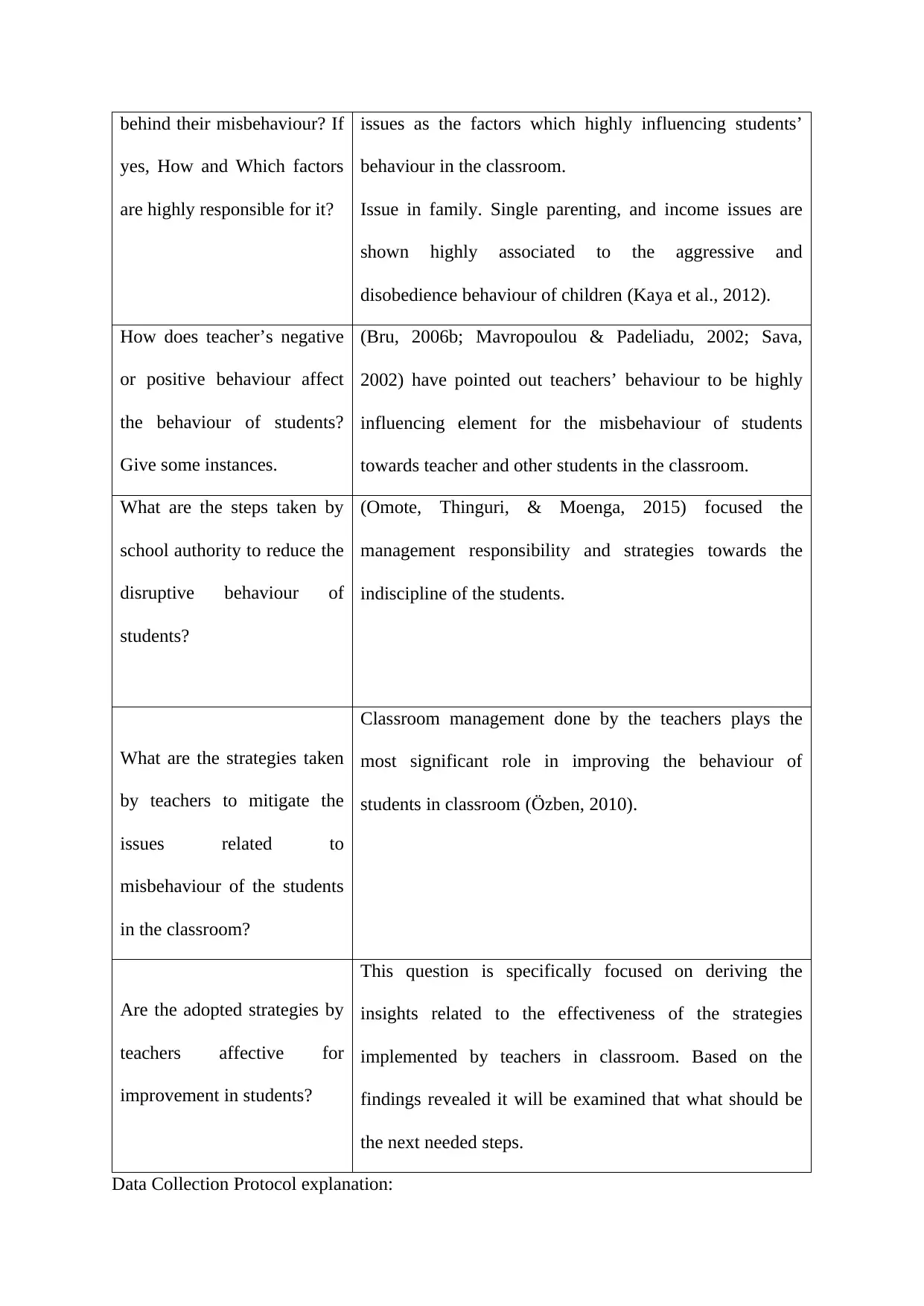
behind their misbehaviour? If
yes, How and Which factors
are highly responsible for it?
issues as the factors which highly influencing students’
behaviour in the classroom.
Issue in family. Single parenting, and income issues are
shown highly associated to the aggressive and
disobedience behaviour of children (Kaya et al., 2012).
How does teacher’s negative
or positive behaviour affect
the behaviour of students?
Give some instances.
(Bru, 2006b; Mavropoulou & Padeliadu, 2002; Sava,
2002) have pointed out teachers’ behaviour to be highly
influencing element for the misbehaviour of students
towards teacher and other students in the classroom.
What are the steps taken by
school authority to reduce the
disruptive behaviour of
students?
(Omote, Thinguri, & Moenga, 2015) focused the
management responsibility and strategies towards the
indiscipline of the students.
What are the strategies taken
by teachers to mitigate the
issues related to
misbehaviour of the students
in the classroom?
Classroom management done by the teachers plays the
most significant role in improving the behaviour of
students in classroom (Özben, 2010).
Are the adopted strategies by
teachers affective for
improvement in students?
This question is specifically focused on deriving the
insights related to the effectiveness of the strategies
implemented by teachers in classroom. Based on the
findings revealed it will be examined that what should be
the next needed steps.
Data Collection Protocol explanation:
yes, How and Which factors
are highly responsible for it?
issues as the factors which highly influencing students’
behaviour in the classroom.
Issue in family. Single parenting, and income issues are
shown highly associated to the aggressive and
disobedience behaviour of children (Kaya et al., 2012).
How does teacher’s negative
or positive behaviour affect
the behaviour of students?
Give some instances.
(Bru, 2006b; Mavropoulou & Padeliadu, 2002; Sava,
2002) have pointed out teachers’ behaviour to be highly
influencing element for the misbehaviour of students
towards teacher and other students in the classroom.
What are the steps taken by
school authority to reduce the
disruptive behaviour of
students?
(Omote, Thinguri, & Moenga, 2015) focused the
management responsibility and strategies towards the
indiscipline of the students.
What are the strategies taken
by teachers to mitigate the
issues related to
misbehaviour of the students
in the classroom?
Classroom management done by the teachers plays the
most significant role in improving the behaviour of
students in classroom (Özben, 2010).
Are the adopted strategies by
teachers affective for
improvement in students?
This question is specifically focused on deriving the
insights related to the effectiveness of the strategies
implemented by teachers in classroom. Based on the
findings revealed it will be examined that what should be
the next needed steps.
Data Collection Protocol explanation:
You're viewing a preview
Unlock full access by subscribing today!
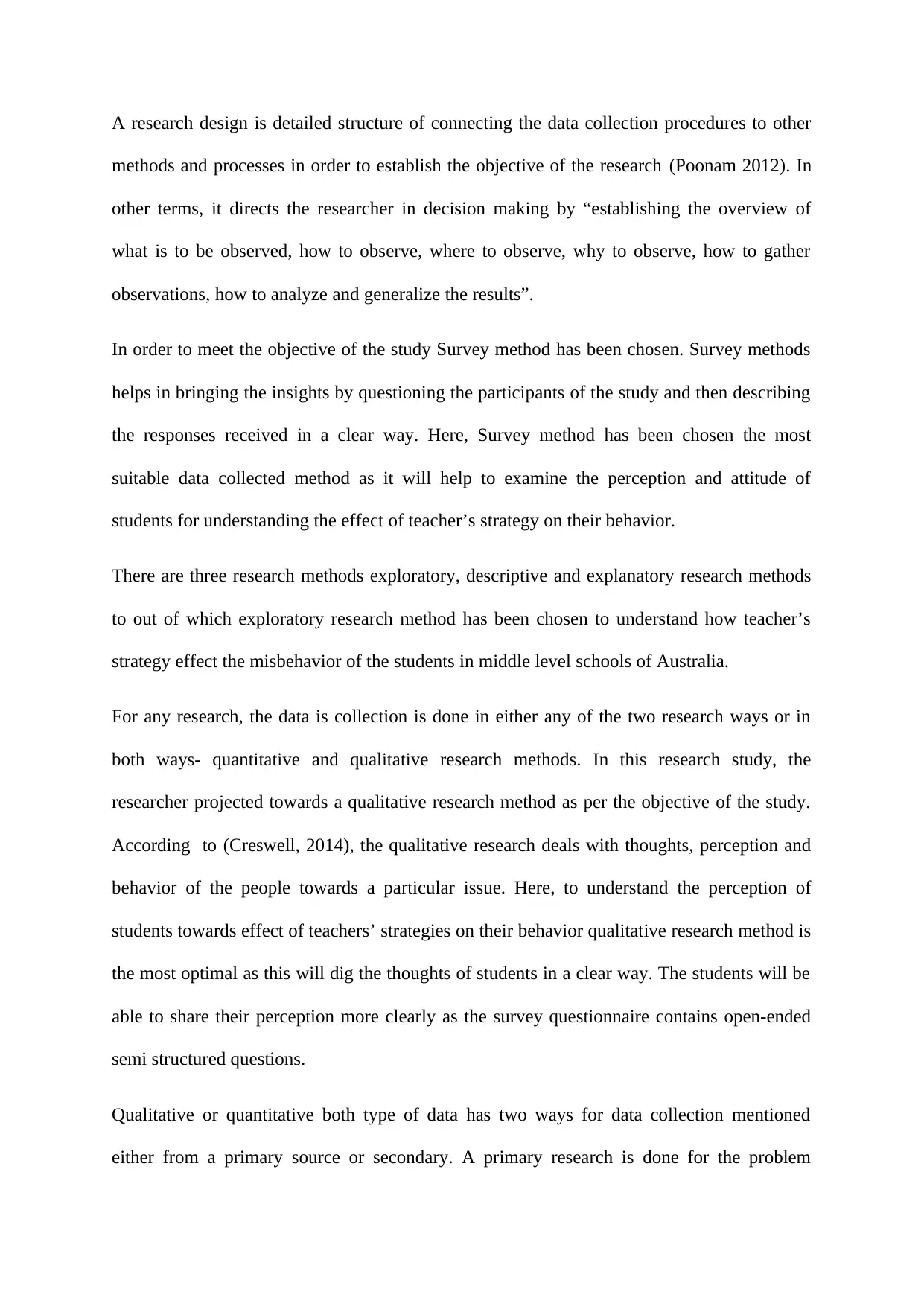
A research design is detailed structure of connecting the data collection procedures to other
methods and processes in order to establish the objective of the research (Poonam 2012). In
other terms, it directs the researcher in decision making by “establishing the overview of
what is to be observed, how to observe, where to observe, why to observe, how to gather
observations, how to analyze and generalize the results”.
In order to meet the objective of the study Survey method has been chosen. Survey methods
helps in bringing the insights by questioning the participants of the study and then describing
the responses received in a clear way. Here, Survey method has been chosen the most
suitable data collected method as it will help to examine the perception and attitude of
students for understanding the effect of teacher’s strategy on their behavior.
There are three research methods exploratory, descriptive and explanatory research methods
to out of which exploratory research method has been chosen to understand how teacher’s
strategy effect the misbehavior of the students in middle level schools of Australia.
For any research, the data is collection is done in either any of the two research ways or in
both ways- quantitative and qualitative research methods. In this research study, the
researcher projected towards a qualitative research method as per the objective of the study.
According to (Creswell, 2014), the qualitative research deals with thoughts, perception and
behavior of the people towards a particular issue. Here, to understand the perception of
students towards effect of teachers’ strategies on their behavior qualitative research method is
the most optimal as this will dig the thoughts of students in a clear way. The students will be
able to share their perception more clearly as the survey questionnaire contains open-ended
semi structured questions.
Qualitative or quantitative both type of data has two ways for data collection mentioned
either from a primary source or secondary. A primary research is done for the problem
methods and processes in order to establish the objective of the research (Poonam 2012). In
other terms, it directs the researcher in decision making by “establishing the overview of
what is to be observed, how to observe, where to observe, why to observe, how to gather
observations, how to analyze and generalize the results”.
In order to meet the objective of the study Survey method has been chosen. Survey methods
helps in bringing the insights by questioning the participants of the study and then describing
the responses received in a clear way. Here, Survey method has been chosen the most
suitable data collected method as it will help to examine the perception and attitude of
students for understanding the effect of teacher’s strategy on their behavior.
There are three research methods exploratory, descriptive and explanatory research methods
to out of which exploratory research method has been chosen to understand how teacher’s
strategy effect the misbehavior of the students in middle level schools of Australia.
For any research, the data is collection is done in either any of the two research ways or in
both ways- quantitative and qualitative research methods. In this research study, the
researcher projected towards a qualitative research method as per the objective of the study.
According to (Creswell, 2014), the qualitative research deals with thoughts, perception and
behavior of the people towards a particular issue. Here, to understand the perception of
students towards effect of teachers’ strategies on their behavior qualitative research method is
the most optimal as this will dig the thoughts of students in a clear way. The students will be
able to share their perception more clearly as the survey questionnaire contains open-ended
semi structured questions.
Qualitative or quantitative both type of data has two ways for data collection mentioned
either from a primary source or secondary. A primary research is done for the problem
Paraphrase This Document
Need a fresh take? Get an instant paraphrase of this document with our AI Paraphraser
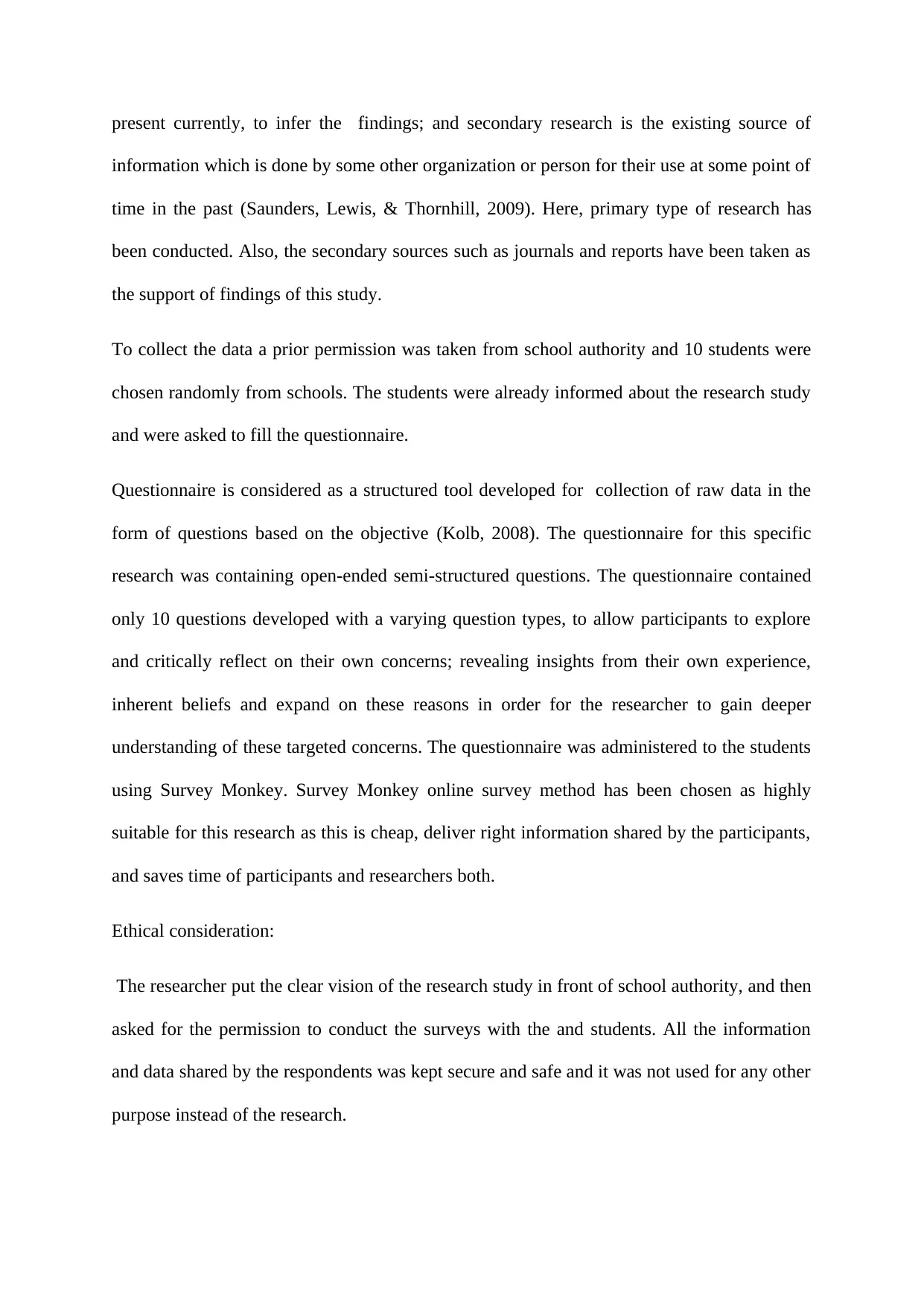
present currently, to infer the findings; and secondary research is the existing source of
information which is done by some other organization or person for their use at some point of
time in the past (Saunders, Lewis, & Thornhill, 2009). Here, primary type of research has
been conducted. Also, the secondary sources such as journals and reports have been taken as
the support of findings of this study.
To collect the data a prior permission was taken from school authority and 10 students were
chosen randomly from schools. The students were already informed about the research study
and were asked to fill the questionnaire.
Questionnaire is considered as a structured tool developed for collection of raw data in the
form of questions based on the objective (Kolb, 2008). The questionnaire for this specific
research was containing open-ended semi-structured questions. The questionnaire contained
only 10 questions developed with a varying question types, to allow participants to explore
and critically reflect on their own concerns; revealing insights from their own experience,
inherent beliefs and expand on these reasons in order for the researcher to gain deeper
understanding of these targeted concerns. The questionnaire was administered to the students
using Survey Monkey. Survey Monkey online survey method has been chosen as highly
suitable for this research as this is cheap, deliver right information shared by the participants,
and saves time of participants and researchers both.
Ethical consideration:
The researcher put the clear vision of the research study in front of school authority, and then
asked for the permission to conduct the surveys with the and students. All the information
and data shared by the respondents was kept secure and safe and it was not used for any other
purpose instead of the research.
information which is done by some other organization or person for their use at some point of
time in the past (Saunders, Lewis, & Thornhill, 2009). Here, primary type of research has
been conducted. Also, the secondary sources such as journals and reports have been taken as
the support of findings of this study.
To collect the data a prior permission was taken from school authority and 10 students were
chosen randomly from schools. The students were already informed about the research study
and were asked to fill the questionnaire.
Questionnaire is considered as a structured tool developed for collection of raw data in the
form of questions based on the objective (Kolb, 2008). The questionnaire for this specific
research was containing open-ended semi-structured questions. The questionnaire contained
only 10 questions developed with a varying question types, to allow participants to explore
and critically reflect on their own concerns; revealing insights from their own experience,
inherent beliefs and expand on these reasons in order for the researcher to gain deeper
understanding of these targeted concerns. The questionnaire was administered to the students
using Survey Monkey. Survey Monkey online survey method has been chosen as highly
suitable for this research as this is cheap, deliver right information shared by the participants,
and saves time of participants and researchers both.
Ethical consideration:
The researcher put the clear vision of the research study in front of school authority, and then
asked for the permission to conduct the surveys with the and students. All the information
and data shared by the respondents was kept secure and safe and it was not used for any other
purpose instead of the research.
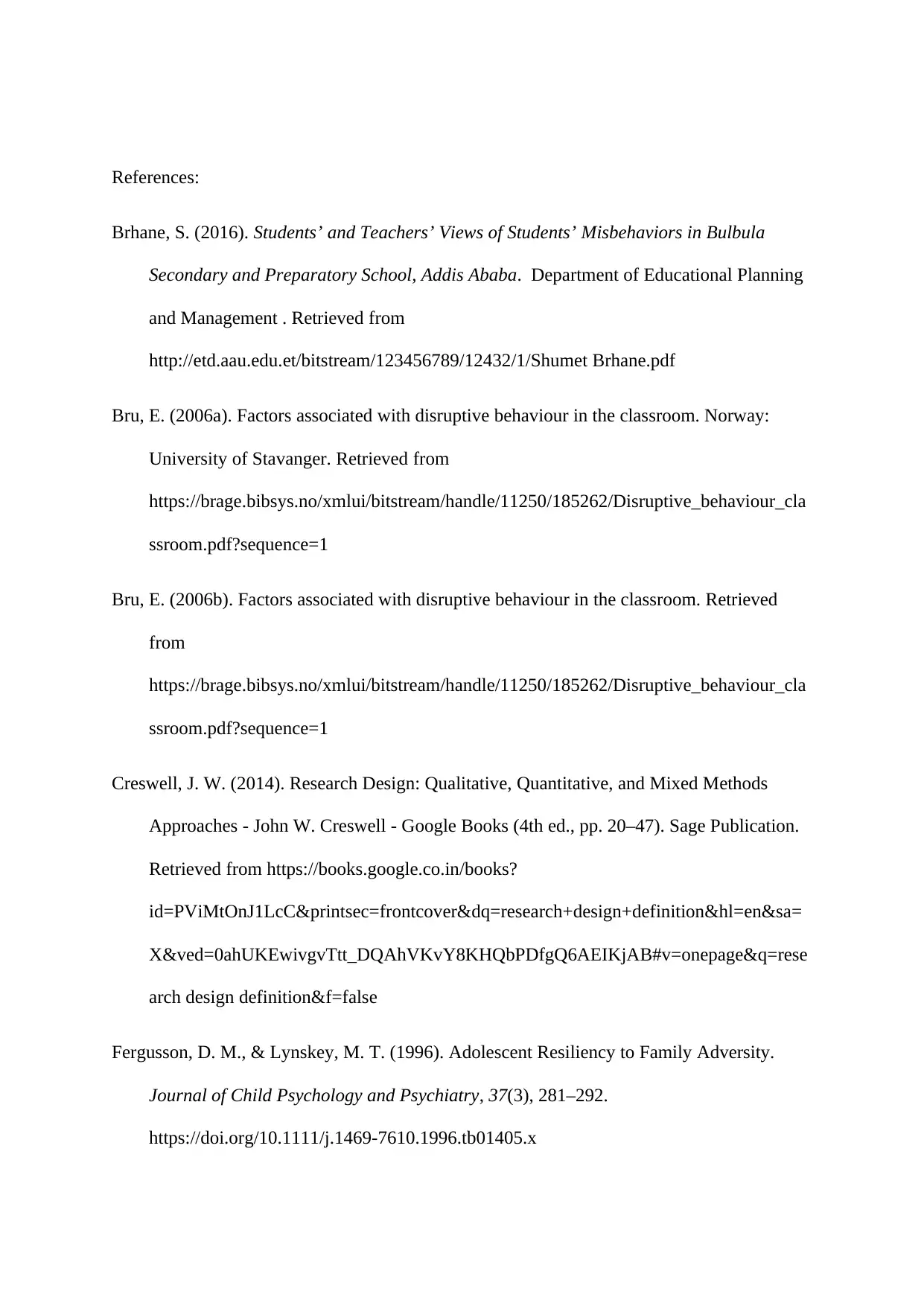
References:
Brhane, S. (2016). Students’ and Teachers’ Views of Students’ Misbehaviors in Bulbula
Secondary and Preparatory School, Addis Ababa. Department of Educational Planning
and Management . Retrieved from
http://etd.aau.edu.et/bitstream/123456789/12432/1/Shumet Brhane.pdf
Bru, E. (2006a). Factors associated with disruptive behaviour in the classroom. Norway:
University of Stavanger. Retrieved from
https://brage.bibsys.no/xmlui/bitstream/handle/11250/185262/Disruptive_behaviour_cla
ssroom.pdf?sequence=1
Bru, E. (2006b). Factors associated with disruptive behaviour in the classroom. Retrieved
from
https://brage.bibsys.no/xmlui/bitstream/handle/11250/185262/Disruptive_behaviour_cla
ssroom.pdf?sequence=1
Creswell, J. W. (2014). Research Design: Qualitative, Quantitative, and Mixed Methods
Approaches - John W. Creswell - Google Books (4th ed., pp. 20–47). Sage Publication.
Retrieved from https://books.google.co.in/books?
id=PViMtOnJ1LcC&printsec=frontcover&dq=research+design+definition&hl=en&sa=
X&ved=0ahUKEwivgvTtt_DQAhVKvY8KHQbPDfgQ6AEIKjAB#v=onepage&q=rese
arch design definition&f=false
Fergusson, D. M., & Lynskey, M. T. (1996). Adolescent Resiliency to Family Adversity.
Journal of Child Psychology and Psychiatry, 37(3), 281–292.
https://doi.org/10.1111/j.1469-7610.1996.tb01405.x
Brhane, S. (2016). Students’ and Teachers’ Views of Students’ Misbehaviors in Bulbula
Secondary and Preparatory School, Addis Ababa. Department of Educational Planning
and Management . Retrieved from
http://etd.aau.edu.et/bitstream/123456789/12432/1/Shumet Brhane.pdf
Bru, E. (2006a). Factors associated with disruptive behaviour in the classroom. Norway:
University of Stavanger. Retrieved from
https://brage.bibsys.no/xmlui/bitstream/handle/11250/185262/Disruptive_behaviour_cla
ssroom.pdf?sequence=1
Bru, E. (2006b). Factors associated with disruptive behaviour in the classroom. Retrieved
from
https://brage.bibsys.no/xmlui/bitstream/handle/11250/185262/Disruptive_behaviour_cla
ssroom.pdf?sequence=1
Creswell, J. W. (2014). Research Design: Qualitative, Quantitative, and Mixed Methods
Approaches - John W. Creswell - Google Books (4th ed., pp. 20–47). Sage Publication.
Retrieved from https://books.google.co.in/books?
id=PViMtOnJ1LcC&printsec=frontcover&dq=research+design+definition&hl=en&sa=
X&ved=0ahUKEwivgvTtt_DQAhVKvY8KHQbPDfgQ6AEIKjAB#v=onepage&q=rese
arch design definition&f=false
Fergusson, D. M., & Lynskey, M. T. (1996). Adolescent Resiliency to Family Adversity.
Journal of Child Psychology and Psychiatry, 37(3), 281–292.
https://doi.org/10.1111/j.1469-7610.1996.tb01405.x
You're viewing a preview
Unlock full access by subscribing today!
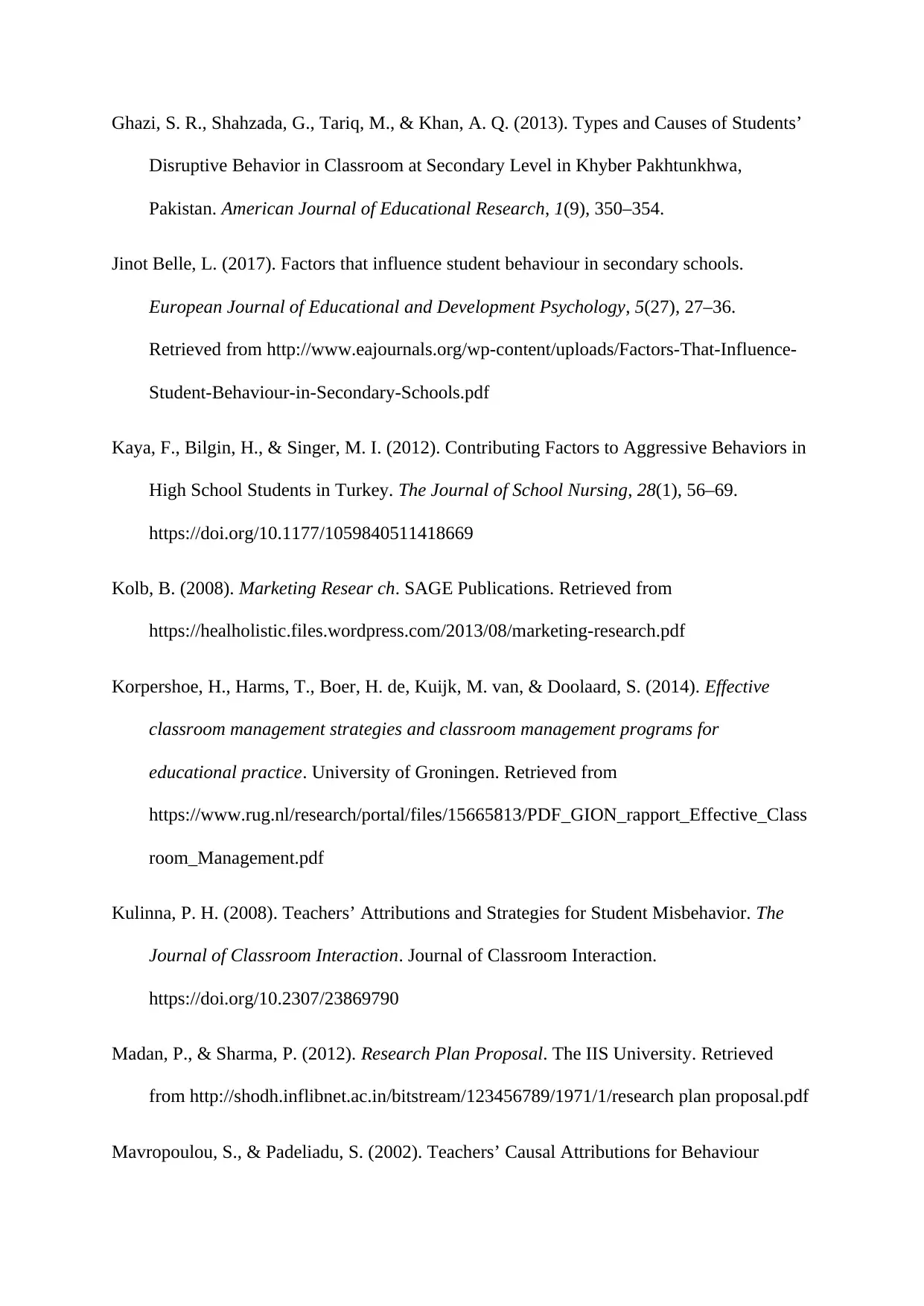
Ghazi, S. R., Shahzada, G., Tariq, M., & Khan, A. Q. (2013). Types and Causes of Students’
Disruptive Behavior in Classroom at Secondary Level in Khyber Pakhtunkhwa,
Pakistan. American Journal of Educational Research, 1(9), 350–354.
Jinot Belle, L. (2017). Factors that influence student behaviour in secondary schools.
European Journal of Educational and Development Psychology, 5(27), 27–36.
Retrieved from http://www.eajournals.org/wp-content/uploads/Factors-That-Influence-
Student-Behaviour-in-Secondary-Schools.pdf
Kaya, F., Bilgin, H., & Singer, M. I. (2012). Contributing Factors to Aggressive Behaviors in
High School Students in Turkey. The Journal of School Nursing, 28(1), 56–69.
https://doi.org/10.1177/1059840511418669
Kolb, B. (2008). Marketing Resear ch. SAGE Publications. Retrieved from
https://healholistic.files.wordpress.com/2013/08/marketing-research.pdf
Korpershoe, H., Harms, T., Boer, H. de, Kuijk, M. van, & Doolaard, S. (2014). Effective
classroom management strategies and classroom management programs for
educational practice. University of Groningen. Retrieved from
https://www.rug.nl/research/portal/files/15665813/PDF_GION_rapport_Effective_Class
room_Management.pdf
Kulinna, P. H. (2008). Teachers’ Attributions and Strategies for Student Misbehavior. The
Journal of Classroom Interaction. Journal of Classroom Interaction.
https://doi.org/10.2307/23869790
Madan, P., & Sharma, P. (2012). Research Plan Proposal. The IIS University. Retrieved
from http://shodh.inflibnet.ac.in/bitstream/123456789/1971/1/research plan proposal.pdf
Mavropoulou, S., & Padeliadu, S. (2002). Teachers’ Causal Attributions for Behaviour
Disruptive Behavior in Classroom at Secondary Level in Khyber Pakhtunkhwa,
Pakistan. American Journal of Educational Research, 1(9), 350–354.
Jinot Belle, L. (2017). Factors that influence student behaviour in secondary schools.
European Journal of Educational and Development Psychology, 5(27), 27–36.
Retrieved from http://www.eajournals.org/wp-content/uploads/Factors-That-Influence-
Student-Behaviour-in-Secondary-Schools.pdf
Kaya, F., Bilgin, H., & Singer, M. I. (2012). Contributing Factors to Aggressive Behaviors in
High School Students in Turkey. The Journal of School Nursing, 28(1), 56–69.
https://doi.org/10.1177/1059840511418669
Kolb, B. (2008). Marketing Resear ch. SAGE Publications. Retrieved from
https://healholistic.files.wordpress.com/2013/08/marketing-research.pdf
Korpershoe, H., Harms, T., Boer, H. de, Kuijk, M. van, & Doolaard, S. (2014). Effective
classroom management strategies and classroom management programs for
educational practice. University of Groningen. Retrieved from
https://www.rug.nl/research/portal/files/15665813/PDF_GION_rapport_Effective_Class
room_Management.pdf
Kulinna, P. H. (2008). Teachers’ Attributions and Strategies for Student Misbehavior. The
Journal of Classroom Interaction. Journal of Classroom Interaction.
https://doi.org/10.2307/23869790
Madan, P., & Sharma, P. (2012). Research Plan Proposal. The IIS University. Retrieved
from http://shodh.inflibnet.ac.in/bitstream/123456789/1971/1/research plan proposal.pdf
Mavropoulou, S., & Padeliadu, S. (2002). Teachers’ Causal Attributions for Behaviour
Paraphrase This Document
Need a fresh take? Get an instant paraphrase of this document with our AI Paraphraser
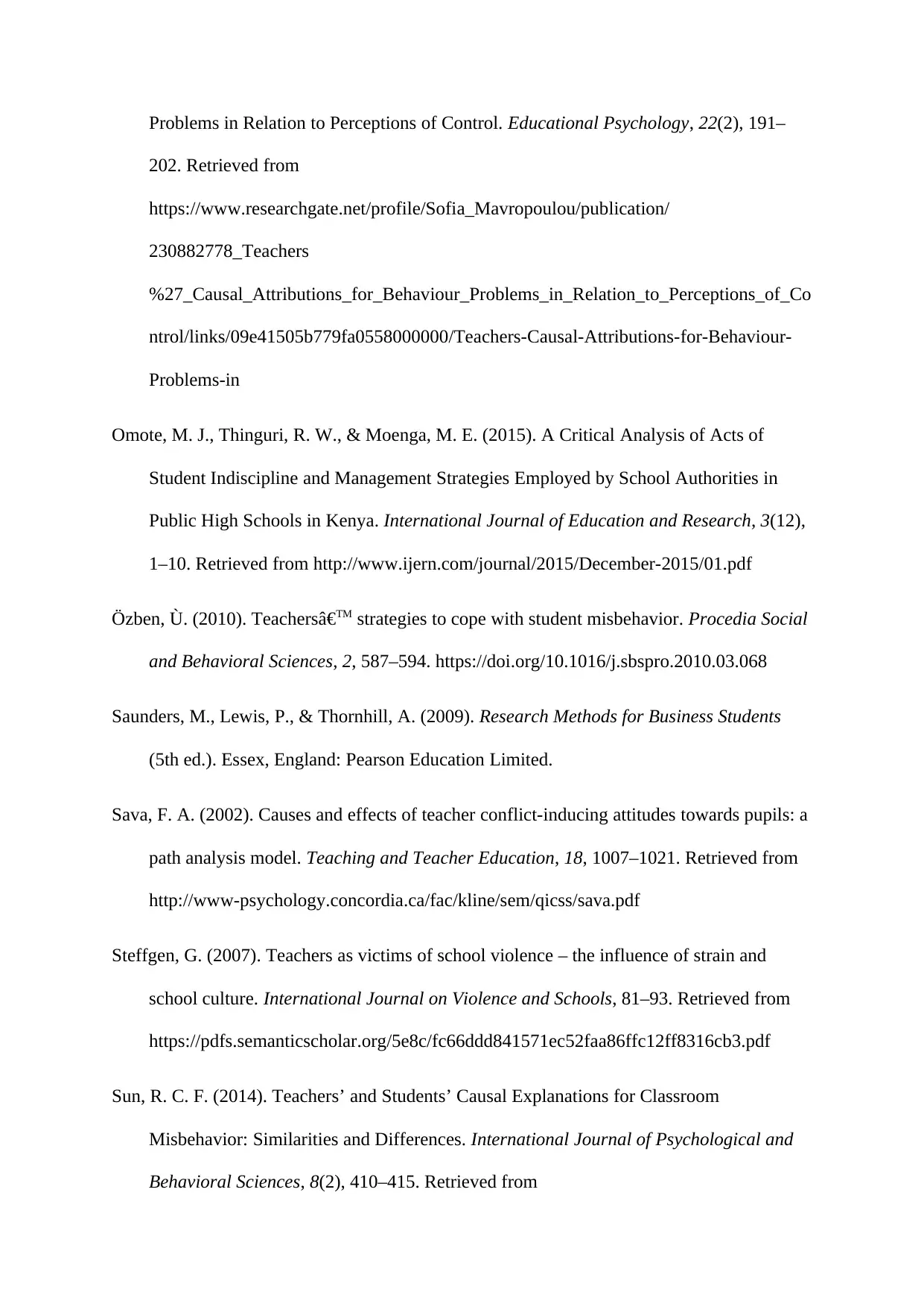
Problems in Relation to Perceptions of Control. Educational Psychology, 22(2), 191–
202. Retrieved from
https://www.researchgate.net/profile/Sofia_Mavropoulou/publication/
230882778_Teachers
%27_Causal_Attributions_for_Behaviour_Problems_in_Relation_to_Perceptions_of_Co
ntrol/links/09e41505b779fa0558000000/Teachers-Causal-Attributions-for-Behaviour-
Problems-in
Omote, M. J., Thinguri, R. W., & Moenga, M. E. (2015). A Critical Analysis of Acts of
Student Indiscipline and Management Strategies Employed by School Authorities in
Public High Schools in Kenya. International Journal of Education and Research, 3(12),
1–10. Retrieved from http://www.ijern.com/journal/2015/December-2015/01.pdf
Özben, Ù. (2010). Teachersâ€TM strategies to cope with student misbehavior. Procedia Social
and Behavioral Sciences, 2, 587–594. https://doi.org/10.1016/j.sbspro.2010.03.068
Saunders, M., Lewis, P., & Thornhill, A. (2009). Research Methods for Business Students
(5th ed.). Essex, England: Pearson Education Limited.
Sava, F. A. (2002). Causes and effects of teacher conflict-inducing attitudes towards pupils: a
path analysis model. Teaching and Teacher Education, 18, 1007–1021. Retrieved from
http://www-psychology.concordia.ca/fac/kline/sem/qicss/sava.pdf
Steffgen, G. (2007). Teachers as victims of school violence – the influence of strain and
school culture. International Journal on Violence and Schools, 81–93. Retrieved from
https://pdfs.semanticscholar.org/5e8c/fc66ddd841571ec52faa86ffc12ff8316cb3.pdf
Sun, R. C. F. (2014). Teachers’ and Students’ Causal Explanations for Classroom
Misbehavior: Similarities and Differences. International Journal of Psychological and
Behavioral Sciences, 8(2), 410–415. Retrieved from
202. Retrieved from
https://www.researchgate.net/profile/Sofia_Mavropoulou/publication/
230882778_Teachers
%27_Causal_Attributions_for_Behaviour_Problems_in_Relation_to_Perceptions_of_Co
ntrol/links/09e41505b779fa0558000000/Teachers-Causal-Attributions-for-Behaviour-
Problems-in
Omote, M. J., Thinguri, R. W., & Moenga, M. E. (2015). A Critical Analysis of Acts of
Student Indiscipline and Management Strategies Employed by School Authorities in
Public High Schools in Kenya. International Journal of Education and Research, 3(12),
1–10. Retrieved from http://www.ijern.com/journal/2015/December-2015/01.pdf
Özben, Ù. (2010). Teachersâ€TM strategies to cope with student misbehavior. Procedia Social
and Behavioral Sciences, 2, 587–594. https://doi.org/10.1016/j.sbspro.2010.03.068
Saunders, M., Lewis, P., & Thornhill, A. (2009). Research Methods for Business Students
(5th ed.). Essex, England: Pearson Education Limited.
Sava, F. A. (2002). Causes and effects of teacher conflict-inducing attitudes towards pupils: a
path analysis model. Teaching and Teacher Education, 18, 1007–1021. Retrieved from
http://www-psychology.concordia.ca/fac/kline/sem/qicss/sava.pdf
Steffgen, G. (2007). Teachers as victims of school violence – the influence of strain and
school culture. International Journal on Violence and Schools, 81–93. Retrieved from
https://pdfs.semanticscholar.org/5e8c/fc66ddd841571ec52faa86ffc12ff8316cb3.pdf
Sun, R. C. F. (2014). Teachers’ and Students’ Causal Explanations for Classroom
Misbehavior: Similarities and Differences. International Journal of Psychological and
Behavioral Sciences, 8(2), 410–415. Retrieved from
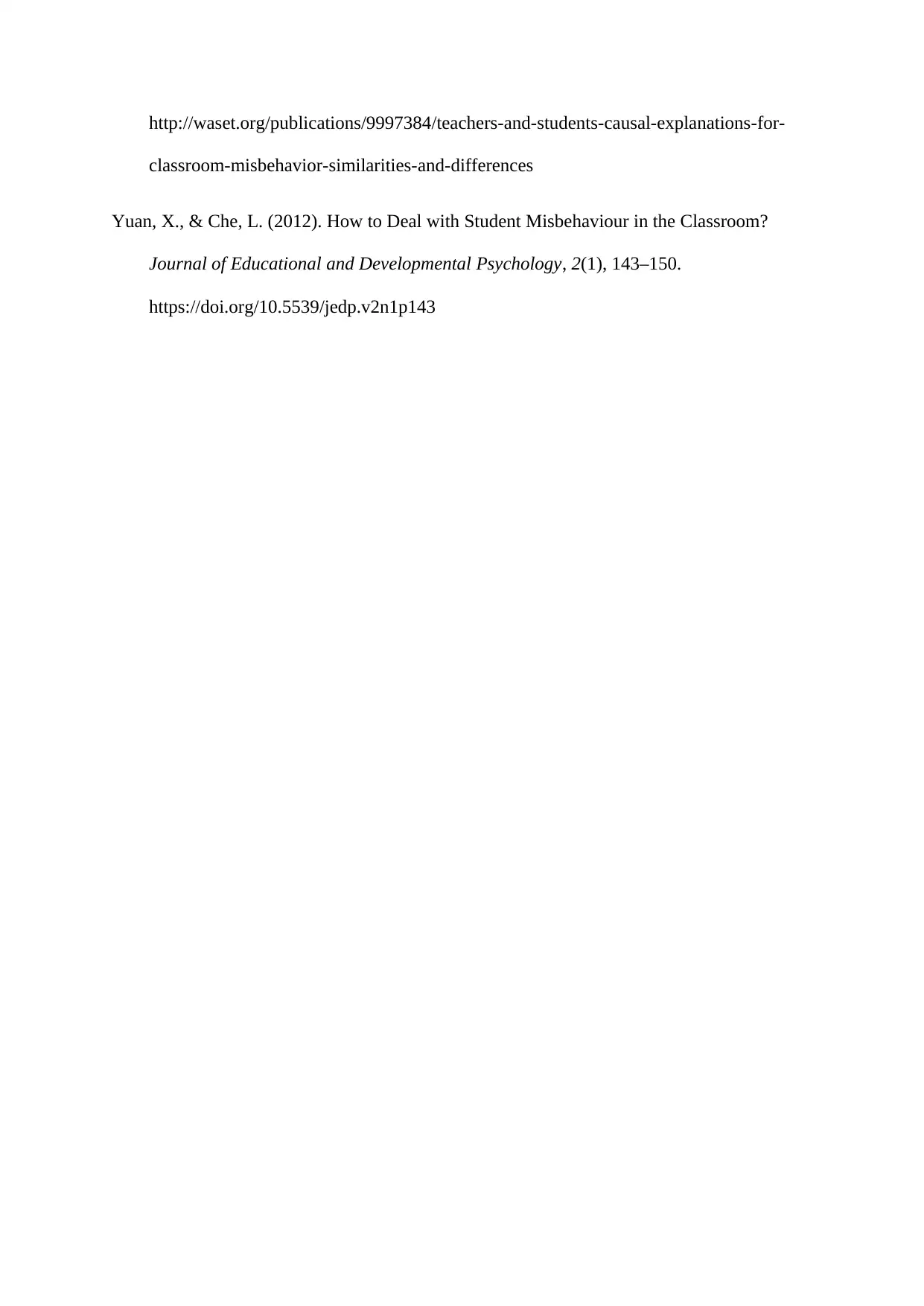
http://waset.org/publications/9997384/teachers-and-students-causal-explanations-for-
classroom-misbehavior-similarities-and-differences
Yuan, X., & Che, L. (2012). How to Deal with Student Misbehaviour in the Classroom?
Journal of Educational and Developmental Psychology, 2(1), 143–150.
https://doi.org/10.5539/jedp.v2n1p143
classroom-misbehavior-similarities-and-differences
Yuan, X., & Che, L. (2012). How to Deal with Student Misbehaviour in the Classroom?
Journal of Educational and Developmental Psychology, 2(1), 143–150.
https://doi.org/10.5539/jedp.v2n1p143
You're viewing a preview
Unlock full access by subscribing today!
1 out of 12
Related Documents
Your All-in-One AI-Powered Toolkit for Academic Success.
+13062052269
info@desklib.com
Available 24*7 on WhatsApp / Email
![[object Object]](/_next/static/media/star-bottom.7253800d.svg)
Unlock your academic potential
© 2024 | Zucol Services PVT LTD | All rights reserved.





